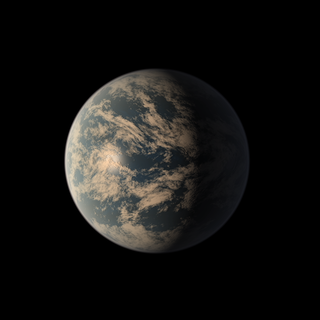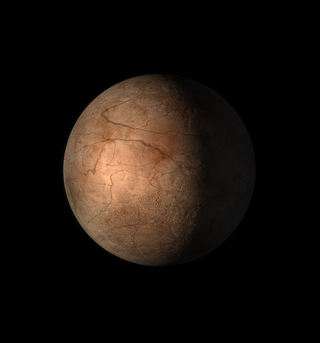
Transit-timing variation is a method for detecting exoplanets by observing variations in the timing of a transit. This provides an extremely sensitive method capable of detecting additional planets in the system with masses potentially as small as that of Earth. In tightly packed planetary systems, the gravitational pull of the planets among themselves causes one planet to accelerate and another planet to decelerate along its orbit. The acceleration causes the orbital period of each planet to change. Detecting this effect by measuring the change is known as transit-timing variations. "Timing variation" asks whether the transit occurs with strict periodicity or if there's a variation.

TRAPPIST-1 is a cool red dwarf star with seven known exoplanets. It lies in the constellation Aquarius about 40.66 light-years away from Earth, and has a surface temperature of about 2,566 K. Its radius is slightly larger than Jupiter and it has a mass of about 9% of the Sun. It is estimated to be 7.6 billion years old, making it older than the Solar System. The discovery of the star was first published in 2000.

SPECULOOS (Search for habitable Planets EClipsing ULtra-cOOl Stars) is a project consisting of SPECULOOS Southern Observatory (SSO) at the Paranal Observatory in Chile and SPECULOOS Northern Observatory (SNO) at the Teide Observatory in Tenerife.

TRAPPIST-1d, also designated as 2MASS J23062928-0502285 d, is a small exoplanet, which orbits on the inner edge of the habitable zone of the ultracool dwarf star TRAPPIST-1, located 40.7 light-years away from Earth in the constellation of Aquarius. The exoplanet was found by using the transit method, in which the dimming effect that a planet causes as it crosses in front of its star is measured. The first signs of the planet were announced in 2016, but it wasn't until the following years that more information concerning the probable nature of the planet was obtained. TRAPPIST-1d is the second-least massive planet of the system and is likely to have a compact hydrogen-poor atmosphere similar to Venus, Earth, or Mars. It receives just 4.3% more sunlight than Earth, placing it on the inner edge of the habitable zone. It has about <5% of its mass as a volatile layer, which could consist of atmosphere, oceans, and/or ice layers. A 2018 study by the University of Washington concluded that TRAPPIST-1d might be a Venus-like exoplanet with an uninhabitable atmosphere. The planet is an eyeball planet candidate.

TRAPPIST-1b, also designated as 2MASS J23062928-0502285 b, is a mainly rocky exoplanet orbiting around the ultra-cool dwarf star TRAPPIST-1, located 40.7 light-years away from Earth in the constellation of Aquarius. The planet was detected using the transit method, where a planet dims the host star's light as it passes in front of it. It was first announced on May 2, 2016, and later studies were able to refine its physical parameters.

TRAPPIST-1c, also designated as 2MASS J23062928-0502285 c, is a mainly rocky exoplanet orbiting around the ultracool dwarf star TRAPPIST-1, located 40.7 light-years away from Earth in the constellation Aquarius. It is the third most massive and third largest planet of the system, with about 131% the mass and 110% the radius of Earth. Its density indicates a primarily rocky composition, and observations by the James Webb Space Telescope announced in 2023 suggests against a thick CO2 atmosphere, however this does not exclude a thick abiotic oxygen-dominated atmosphere as is hypothesized to be common around red dwarf stars.

An ultra-cool dwarf is a stellar or sub-stellar object that has an effective temperature lower than 2,700 K . This category of dwarf stars was introduced in 1997 by J. Davy Kirkpatrick, Todd J. Henry, and Michael J. Irwin. It originally included very low mass M-dwarf stars with spectral types of M7 but was later expanded to encompass stars ranging from the coldest known to brown dwarfs as cool as spectral type T6.5. Altogether, ultra-cool dwarfs represent about 15% of the astronomical objects in the stellar neighborhood of the Sun. One of the best known examples is TRAPPIST-1.

TRAPPIST-1f, also designated as 2MASS J23062928-0502285 f, is an exoplanet, likely rocky, orbiting within the habitable zone around the ultracool dwarf star TRAPPIST-1, located 40.7 light-years away from Earth in the constellation of Aquarius. The exoplanet was found by using the transit method, in which the dimming effect that a planet causes as it crosses in front of its star is measured.

TRAPPIST-1e, also designated as 2MASS J23062928-0502285 e, is a rocky, close-to-Earth-sized exoplanet orbiting within the habitable zone around the ultracool dwarf star TRAPPIST-1, located 40.7 light-years away from Earth in the constellation of Aquarius. Astronomers used the transit method to find the exoplanet, a method that measures the dimming of a star when a planet crosses in front of it.

TRAPPIST-1h, also designated as 2MASS J23062928-0502285 h, is an exoplanet orbiting around the ultra-cool dwarf star TRAPPIST-1, located 40.7 light-years away from Earth in the constellation Aquarius. It was one of four new exoplanets to be discovered orbiting the star in 2017 using observations from the Spitzer Space Telescope. In the following years, more studies were able to refine its physical parameters.
WASP-121, also known as CD-38 3220, is a magnitude 10.4 star located approximately 858 light-years away in the constellation Puppis. WASP-121 has a mass and radius similar to the Sun's. It hosts one known exoplanet.

Ross 128 b is a confirmed Earth-sized exoplanet, likely rocky, that is orbiting within the inner habitable zone of the red dwarf star Ross 128, at a distance of around 11 light-years from Earth. The exoplanet was found using a decade's worth of radial velocity data using the European Southern Observatory's HARPS spectrograph at the La Silla Observatory in Chile. Ross 128 b is the nearest exoplanet around a quiet red dwarf, and is considered one of the best candidates for habitability. The planet is only 35% more massive than Earth, receives only 38% more starlight, and is expected to be a temperature suitable for liquid water to exist on the surface, if it has an atmosphere.
K2-315b is an exoplanet located 185.3 light years away from Earth in the southern zodiac constellation Libra. It orbits the red dwarf K2-315.
WASP-72 is the primary of a binary star system. It is an F7 class dwarf star, with an internal structure just on the verge of the Kraft break. It is orbited by a planet WASP-72b. The age of WASP-72 is younger than the Sun at 3.55±0.82 billion years.
WASP-80 is a K-type main-sequence star about 162 light-years away from Earth. The star's age is much younger than the Sun's at 1.352±0.222 billion years. WASP-80 could be similar to the Sun in concentration of heavy elements, although this measurement is highly uncertain.
WASP-103b is a gaseous exoplanet, more specifically a hot Jupiter, located in the Hercules constellation orbiting the star WASP-103. It has an oval shape, similar to that of a rugby ball, thanks to the force of gravity exerted by its star. It is the first exoplanet to have a deformation detected.















